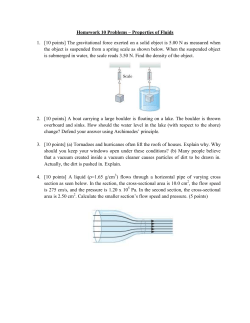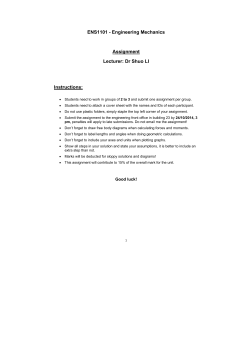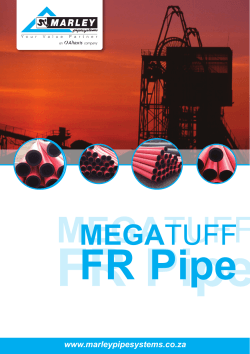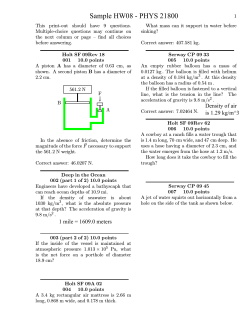
Water Main Installation - American Water Works Association
Water Main Installation Using Trenchless Methods Water Main Installation - Trenchless Overview: • Introduction • Design Considerations o Geotechnical Investigations o Subsurface Utilities • Various Installation Methods o Horizontal Directional Drill o Horizontal Auger Bore o Pipe Ram o Microtunneling o Pipe Burst • Summary and Resources Introduction • Conventional Method - Open Cut o o o Excavation and Shoring Backfilling and Compaction Pavement Restoration • Alternative Method - Trenchless o o Excavation Pits are still needed Therefore “Less Trench” • Trenchless Construction and Renewal Methods Trenchless Construction Methods Horizontal Auger Boring, Horizontal Directional Drilling, Pipe Ramming, Microtunneling, In-line Replacement Trenchless Renewal Methods Slipline, Cured In Place, Thermoformed Pipe, In-line Replacement, Localized Repair History • • • • • • • • • • • 1930 – early stages of HDD through vertical oil drilling 1936 – Horizontal Auger Boring originates in Coal Mining in PA 1971 – HDD introduced: 600 ft - 4” pipe river crossing in CA 1975 – Microtunneling developed in Japan 1977 – Pipe Bursting developed in United Kingdom 1984 – 12 HDD units exist 1986 – Establishment of ISTT 1990 – Formation of NASTT 2001 – Publication of HDD Consortium HDD Good Practices 2005 – Publication of ASCE HDD Manual of Practice 2015 – Thousands of HDD units exist today North America – HDD developed from vertical steered oil well drilling, HAB developed from coal mining Japan - Microtunneling evolved out of a demand for more sewer systems in the larger cities United Kingdom - Trenchless technologies were used to replace and fix aging pipes from the Industrial Revolution By 1986 Japanese, American, and European engineers banded together to officially categorize all of these techniques under the umbrella of trenchless technology Why Use Trenchless ? FAMILY FEUD FAMILY FEUD FAMILY FEUD FAMILY FEUD FAMILY FEUD FAMILY FEUD FAMIL ILY FEUD FAMILY FEUD FAMILY FEUD FAMILY FEUD FAMILY FEUD FAMILY FEUD FAMILY FE Minimize Traffic / Operations Disruption 24 Damage to Utilities / Structures 11 Environmental Impact 20 Capital Cost 7 Road and Pavement Damage 17 Heavy Construction / Air Pollution 5 Site and Public Safety 14 Win Lose Cheer Boo Silence Design Considerations Geotechnical Investigations • Conduct Geotechnical Borings • Conduct away of proposed path • Useful Geotech Information: o Water table o Presence of Rock / Cobbles o Soil Strength and Stability o SPT tests at 5’ intervals o Grain Size Analyses o Unconfined compression tests • Geotechnical Engineer Report Slide 8 of 28 Design Considerations Subsurface Utilities Records Supplemented with Field Research and Geophysical Methods • Electro-Magnetic Methods • Pipe and Cable Locators • Ground Penetrating Radar Precise horizontal and vertical location of utilities obtained by the actual exposure. • Vacuum Excavation Test Hole • Utility Pipe is Exposed HORIZONTAL DIRECTIONAL DRILL (HDD) Horizontal Directional Drill (HDD) Mini-HDD: • Boring a small diameter pilot hole using a cutting head with high pressure fluid. • When the cutting head reaches the far side, the pipe is then pulled into place behind a reamer. Short lengths up to 12” pipe size, at shallow depths Maxi-HDD: Longer lengths, over 24” pipe size, at greater depths Horizontal Directional Drill Process 1. Pilot bore • Guided using steering head 2. Back Ream • Multiple reams for larger pipes • Drilling fluid maintains borehole stability 3. Pullback • Pipe to withstand pulling forces • Rig to overcome frictional forces Horizontal Directional Drill Horizontal Directional Drill Design • Work Area Requirements o Small diameter – very little excavation o Large diameter – considerable area required Rig Side: 20,000 sf Pipe Side: Pre-assemble pipe string Frac Tanks Equipment Trailer 80’ to 180’ Boom truck Solids Containers Bore Drill Pipe Storage Mud Tanks and Pumps 150’ to 250’ Entry Pit Drill Rig Power Unit Control Cab Horizontal Directional Drill Design • Geometry o Entry Angles (8 o to 16 o) o Exit Angles (5 o to 10 o ) o Minimum Depth o Bend Radius Horizontal Directional Drill Equipment and Materials • Drill Bits o Slant faced bits o Rotary rock bits • Reamers o Mixing reamers o Compaction reamers • Drilling Fluid Support System o o Drill Fluids Transport cuttings Cleaning drill bits or reamers Cooling downhole tools Lubricate to reduce friction Stabilize borehole Cleaning / Separation Systems Horizontal Directional Drill Troubleshooting • Hydrofracture or “frac-out” o Shallow cover, thin drilling fluid, adjacent boreholes, fissures, utilities, loose soil, gravels, high drilling pressures • Loss of Circulation • Collapse of Borehole • Settlement / Surface Heave • Obstructions • Pipe Stuck in Borehole • Possible Solutions: o Increase fluid pressure / Adjust pumping rates o Increase viscosity of drilling fluid o Pull back and change alignment o Change drill bit o Install conductor casing Horizontal Directional Drill Summary Table Mini Midi Maxi Typical Application Telecom, power cables, small diameter pipe Water and pipeline – Rivers and Roadway Water and pipeline – Large River and Highway Diameter Ranges 2 to 12 in 12 to 24 in 24 to 48 in Typical Lengths < 600 ft < 1,000 ft < 6,000 ft Depth < 15 ft < 75 ft < 200 ft Working Space minimal 400’ x 200’ rig side; Pullback side varies 400’ x 200’ rig side; Pullback side varies Pipe Material Typically HDPE Typically Steel, HDPE, Fusible PVC (restrained joint PVC and DI can also be used) Soil Conditions Clay : IDEAL Significant rock: NO Gravels / Small Rock: MARGINAL All others soils: SUITABLE Clay : IDEAL Significant rock: MARGINAL Gravels / Small Rock: MARGINAL All others soils: SUITABLE Productivity 600 ft / day varies Advantages (1) Steering capability, (2) Drive and reception pits not required, (3) Long drive lengths Limitations (1) Disposal of slurry mixed cuttings, (2) Slurry migration varies HORIZONTAL AUGER BORE Horizontal Auger Bore • Pushing the pipe with a boring auger rotating within the pipe to remove the spoil. Jacks can also be used against a backstop. Auger Bore • Horizontal Auger Boring o Cradle Type o Track Type • Components (Track) o Shaft and Track System o Cutting Head o Augers and Casing o Boring Machine Auger Bore • Process 1. Pit prep and installation of track 2. Casing pipe and augers in front of Auger Machine 3. Torque and Thrust transmitted to cutting head through auger string 4. Auger Machine retracted. New segment installed. • Pit Sizes o Drive Shaft: Auger Machine + Casing Segment o Typical pit is 35 ft long (20’ casing) x 10 ft wide. o Sufficient Space at surface for loading / unloading PIPE RAM Pipe Ram • Pushing the pipe using force transmitted by a percussion hammer attached to the end of a pipe. Pipe Ram Cutting shoe welded to leading edge Ramming plate (ram cone or ram collets) Pipe hammer is comprised of a double-acting pneumatically driven piston, delivering up to 240 blows per minute Leading edge typically open for larger pipe Bearing stands for pipe Auger Bore / Pipe Ram Summary Table Auger Bore Pipe Ram Typical Application Rail, Roadway ,or River crossing Roadway or River crossing Diameter Ranges 4 to 60 in 4 to 60 in (120 in has been installed) Typical Lengths 100 to 600 ft 200 to 300 ft Working Space Shafts at both ends. Drive shaft length = pipe + equip (typically 35’ x 12’). Surface Area 50’ x 100’ Pipe Material Casing: Steel Carrier: Any material Soil Conditions Firm Sandy Clay: IDEAL Sand below water: NO Loose Sand above water: MARGINAL Rock over 1/3 Dia: MARGINAL Rock up to 1/3 Dia: SUITABLE All others soils: SUITABLE Productivity Approx 6 ft per hr for 24” dia (not including pit and auger prep) Advantages (1) Casing is installed as borehole excavation takes place (no borehole collapse) (2) Versatile in variety of soil types Limitations (1) Requires substantial pits and accurate set-up (2) May require dewatering Soft Clays, Sands: IDEAL Solid Rock: NO Sand below water: MARGINAL Hard Clays: MARGINAL Weathered Rock: MARGINAL All others soils: SUITABLE (1) Can sometimes be performed in wet conditions (2) Same as Auger Bore MICROTUNNELING Microtunneling • Remotely controlled guided pipe jacking operation that does not require worker entry in the tunnel. Microtunneling • Remotely controlled, guided, pipe-jacking operation • Pipes pushed behind Microtunneling Boring Machine (MTBM) using hydraulic jacks • Provides continuous support to excavation face through fluid pressure • Components: o Crushing Cone o Closed loop slurry system o Slurry cleaning system o Guidance System Microtunneling Rotation drive Supply pipe Conveyor pipe Hydraulic Pump Cutting wheel and extraction tool Crusher space Microtunneling Summary Table Microtunneling Diameter Ranges 10 to 136 in (typical is 24 to 48 in) Typical Lengths 500 to 1500 ft Depth 5 ft minimum Working Space Varies, typically 30 ft x 100 ft Pipe Material Casing: Steel, RCP, or PCP Carrier: Any material Soil Conditions Wet sand: IDEAL Rock up to 1/3 Dia: MARGINAL Large Rock: NO All others soils: SUITABLE Productivity 6ft per hr Advantages (1) Capable of very accurate lines and grades (2) Can be performed in groundwater (3) Worker entry not required Limitations (1) Problems caused by large boulders (2) Equipment capital cost is high PIPE BURST Pipe Burst Design Considerations • Soil Conditions • Adjacent utilities • Pipe Bends • Depth (surface heave) General Rule One foot of cover for every inch Of expansion Pipe Burst Summary Table Pneumatic Static Typical Application In-line pipe replacement Diameter Ranges 2 to 36 in (48 in has been performed) Typical Lengths 300 to 400 ft Depth Any depth of existing pipe Working Space Insertion pit 8’ x 15’ Insertion pit 8’ x 15’ (longer if cartridge method used) Pipe Material Typically HDPE Typically HDPE, however, can be any material including DI Soil Conditions Expandable Clay: IDEAL Dense Clay and Sandstone: DIFFICULT All others soils: SUITABLE Productivity Approx 50 to 100 ft per hr (not including pit prep) Advantages (1) Ability to upsize pipes (2) New pipe will follow alignment of existing Limitations (1) Reconnection of laterals by open cut is required (2) Bypassing flow is required (3) Potential ground displacement Water Main Installation - Trenchless Pipe Ramming • • Casing is installed as borehole excavation takes place Can be installed in wet conditions Microtunneling • • • Accurate lines and grades Can be in groundwater Worker entry not required HDD • • • Steering capability Drive and reception pits not required Long drive lengths Pipe Bursting • • Ability to upsize pipe Follows alignment of existing Auger Boring • • Casing is installed as borehole excavation takes place Versatile in variety of soil types Water Main Installation - Trenchless Summary and Take Away Points • Trenchless means “Less Trench” • Geotechnical and Subsurface investigations crucial • HDD, HAB, MT, Pipe Ram, Pipe Burst all have different advantages and limitations • Plan for pitfalls: Frac-out, obstructions, settlement • In many cases, Trenchless has favorable economic costs due to less surface restoration and MPT • In almost all cases, Trenchless has favorable social and environmental costs Water Main Installation - Trenchless Thank you References: • • • • • • • • • • ISTT (International Society for Trenchless Technology) NASTT (North American Society for Trenchless Technology) Trenchless Technology by Mohammad Najafi Horizontal Directional Drilling by David Willoughby HDD Good Practices Guidelines by HDD Consortium IPBA (International Pipe Bursting Association) ASTM F1962 – Maxi-HDD for Placement of PE Pipe TT Technologies Prime Drilling Herrenknecht Inc. Presenter: Ken Bienkowski, P.E. Jacobs Engineering (862) 242-7284 Ken.Bienkowski@jacobs.com
© Copyright 2025









